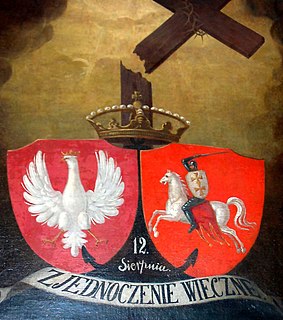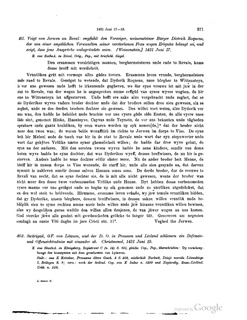 W
WThe Polish–Lithuanian Union was a relationship created by a series of acts and alliances between the Crown of the Kingdom of Poland and the Grand Duchy of Lithuania that lasted for prolonged periods of time from 1385 and led to the creation of the Polish–Lithuanian Commonwealth - the "Republic of the Two Nations" - in 1569 and eventually to the creation of a unitary state in 1791.
 W
WThe Congress of Lutsk was a diplomatic gathering held in Lubart's Castle in Lutsk, Grand Duchy of Lithuania over a 13-week period beginning on January 6, 1429. The main topic of discussion was the coronation of Vytautas as King of Lithuania. Other topics included: the siege of Moldavia; a potential coalition against the Ottoman Empire; the desire for improved relations between Denmark and the Hanseatic League; religious unions and divisions; as well as various economic, trade, and tax-related issues.
 W
WThe Gollub War was a two-month war of the Teutonic Knights against the Kingdom of Poland and the Grand Duchy of Lithuania in 1422. It ended with the signing the Treaty of Melno, which resolved territorial disputes between the Knights and Lithuania over Samogitia that had dragged on since 1398.
 W
WThe Lithuanian Civil War of 1432–1438 was a conflict over the succession to the throne of the Grand Duchy of Lithuania, after Vytautas the Great died in 1430 without leaving an heir. The war was fought on the one side by Švitrigaila, allied with the Teutonic Knights, and on the other by Sigismund Kęstutaitis, backed by the Kingdom of Poland. The war threatened to sever the Union of Krewo, the personal union between Poland and Lithuania. Švitrigaila's alliance with the Grand Master of the Teutonic Order, Paul von Rusdorf, launched the Polish–Teutonic War (1431–1435) but failed to secure victory for Švitrigaila.
 W
WThe Pact of Vilnius and Radom was a set of three acts passed in Vilnius, Grand Duchy of Lithuania, and confirmed by the Crown Council in Radom, Kingdom of Poland in 1401. The union amended the earlier act of the Union of Krewo (1385) and confirmed the Ostrów Agreement (1392). Vytautas, Grand Duke of Lithuania, became fully in charge of the Lithuanian affairs, while Władysław II Jagiełło, King of Poland, reserved the rights of an overlord. After the death of Vytautas, Lithuania was to be ruled by Władysław II Jagiełło or his legal heir. The union is generally seen as strengthening of the Polish–Lithuanian union.
 W
WPeace of Raciążek was a treaty signed on 22 May 1404 between Kingdom of Poland, Grand Duchy of Lithuania, and the Teutonic Knights, regarding the control of the Dobrzyń Land and Samogitia. Poland in essence confirmed the Treaty of Kalisz of 1342 and Lithuania – the Treaty of Salynas of 1398. The treaty was not stable and the situation soon changed with the Polish-Lithuanian–Teutonic War of 1409–1411.
 W
WThe (First) Peace of Thorn was a peace treaty formally ending the Polish–Lithuanian–Teutonic War between allied Kingdom of Poland and Grand Duchy of Lithuania on one side, and the Teutonic Knights on the other. It was signed on 1 February 1411 in Thorn (Toruń), one of the southernmost cities of the Monastic State of the Teutonic Knights. In historiography, the treaty is often portrayed as a diplomatic failure of Poland–Lithuania as they failed to capitalize on the decisive defeat of the Knights in the Battle of Grunwald in June 1410. The Knights returned Dobrzyń Land which they captured from Poland during the war and made only temporary territorial concessions in Samogitia, which returned to Lithuania only for the lifetimes of Polish King Władysław Jagiełło and Lithuanian Grand Duke Vytautas. The Peace of Thorn was not stable. It took two other brief wars, the Hunger War in 1414 and Gollub War in 1422, to sign the Treaty of Melno that solved the territorial disputes. However, large war reparations were a significant financial burden on the Knights, causing internal unrest and economic decline. The Teutonic Knights never recovered their former might.
 W
WThe Polish–Lithuanian–Teutonic War, or Great War, occurred between 1409 and 1411 between the Teutonic Knights and the allied Kingdom of Poland and Grand Duchy of Lithuania. Inspired by the local Samogitian uprising, the war began by Teutonic invasion of Poland in August 1409. As neither side was ready for a full-scale war, Wenceslaus IV of Bohemia brokered a nine-month truce. After the truce expired in June 1410, the military-religious monks were decisively defeated in the Battle of Grunwald, one of the largest battles in medieval Europe. Most of the Teutonic leadership was killed or taken prisoner. Although they were defeated, the Teutonic Knights withstood the siege on their capital in Marienburg (Malbork) and suffered only minimal territorial losses in the Peace of Thorn (1411). Territorial disputes lasted until the Peace of Melno of 1422. However, the Knights never recovered their former power, and the financial burden of war reparations caused internal conflicts and economic decline in their lands. The war shifted the balance of power in Central Europe and marked the rise of the Polish–Lithuanian union as the dominant power in the region.
 W
WThe Treaty of Christmemel was a treaty signed on 19 June 1431 between Paul von Rusdorf, Grand Master the Teutonic Knights, and Švitrigaila, Grand Duke of Lithuania. Švitrigaila was preparing for a war with Poland to defend his claim to the Lithuanian throne and sought allies. The treaty established an anti-Polish alliance and prompted the Knights to invade the Kingdom of Poland, starting the Polish–Teutonic War (1431–35). Lithuania also surrendered Palanga and three miles of the coastline on the Baltic Sea, thus modifying the Treaty of Melno of 1422.
 W
WThe Treaty of Melno or Treaty of Lake Melno was a peace treaty ending the Gollub War. It was signed on 27 September 1422, between the Teutonic Knights and an alliance of the Kingdom of Poland and the Grand Duchy of Lithuania at Lake Melno, east of Graudenz (Grudziądz). The treaty resolved territorial disputes between the Knights and Lithuania regarding Samogitia, which had dragged on since 1382, and determined the Prussian–Lithuanian border, which afterwards remained unchanged for about 500 years. A portion of the original border survives as a portion of the modern border between the Republic of Lithuania and Kaliningrad Oblast, Russia, making it one of the oldest and most stable borders in Europe.
 W
WThe Union of Grodno was a series of acts of the Polish–Lithuanian union between Kingdom of Poland and Grand Duchy of Lithuania. The first acts were signed in 1432 during the Lithuanian Civil War of 1431–1435. The acts confirmed the Union of Vilnius and Radom (1401). The Union established Sigismund Kęstutaitis as the Grand Duke of Lithuania and re-established Władysław II Jagiełło's seniority and dynastic interest in Lithuania.
 W
WThe Union of Horodło or Pact of Horodło was a set of three acts signed in the town of Horodło on 2 October 1413. The first act was signed by Władysław II Jagiełło, King of Poland, and Vytautas, Grand Duke of Lithuania. The second and third acts were composed by the Polish nobility (szlachta) and Lithuanian boyars, respectively. The union amended the earlier Polish–Lithuanian unions of Krewo and Vilnius–Radom. Politically, Lithuania received more autonomy as, after the death of Vytautas, the Lithuanian nobles could choose another Grand Duke instead of passing the title to Władysław II Jagiełło or his heir. However, culturally, Lithuania and Poland grew closer. Lithuania adopted Polish institutions of castellans and voivodes. Catholic Lithuanian nobles and church officials were granted equal rights with the Polish nobles and clergy. Forty-seven selected Lithuanian nobles were adopted by Polish families and granted Polish coats of arm. Thus the union signified the beginnings of the Polonization of Lithuanian culture and the rise of the Lithuanian nobility. It was one of the major steps towards the modernization and Europeanization of Lithuania.